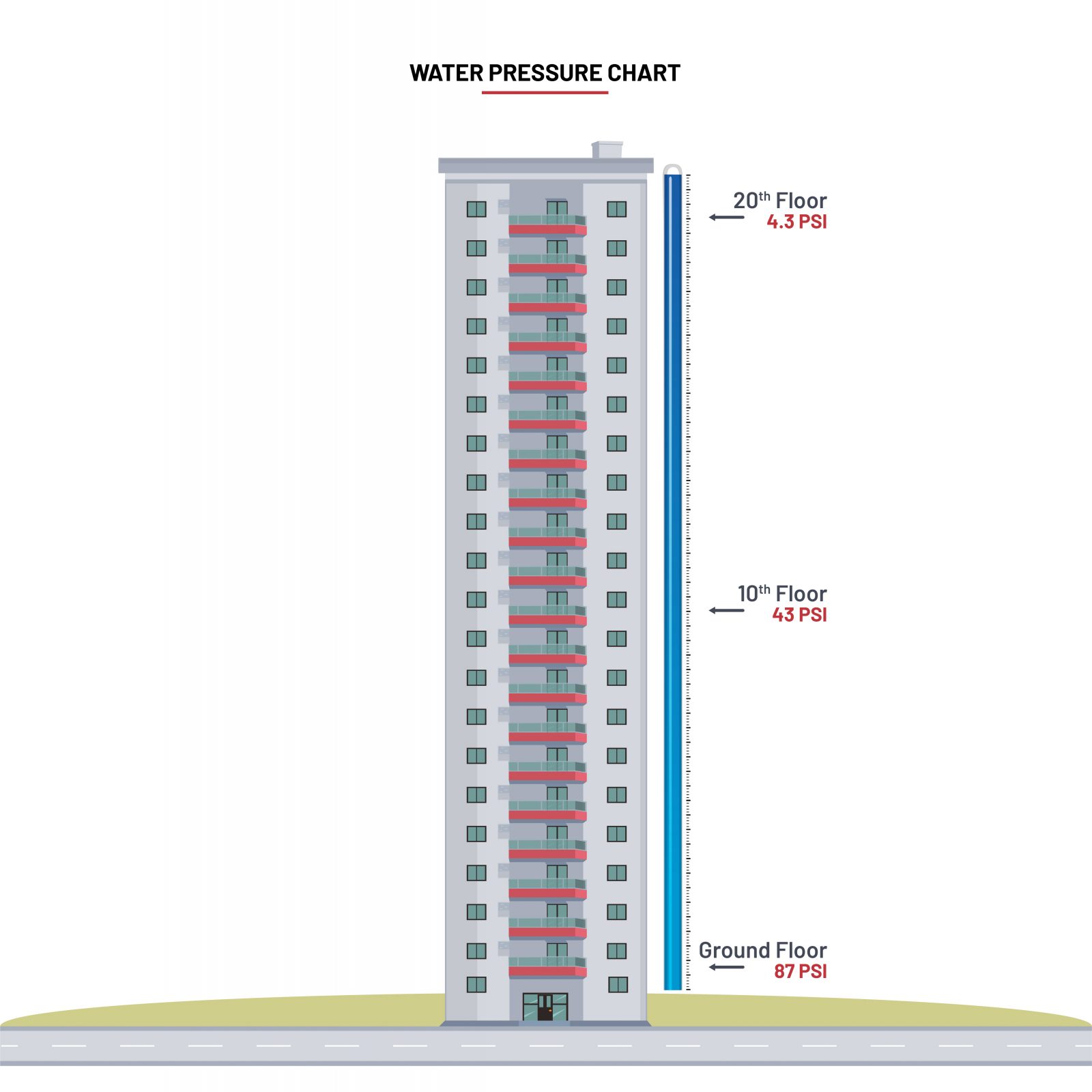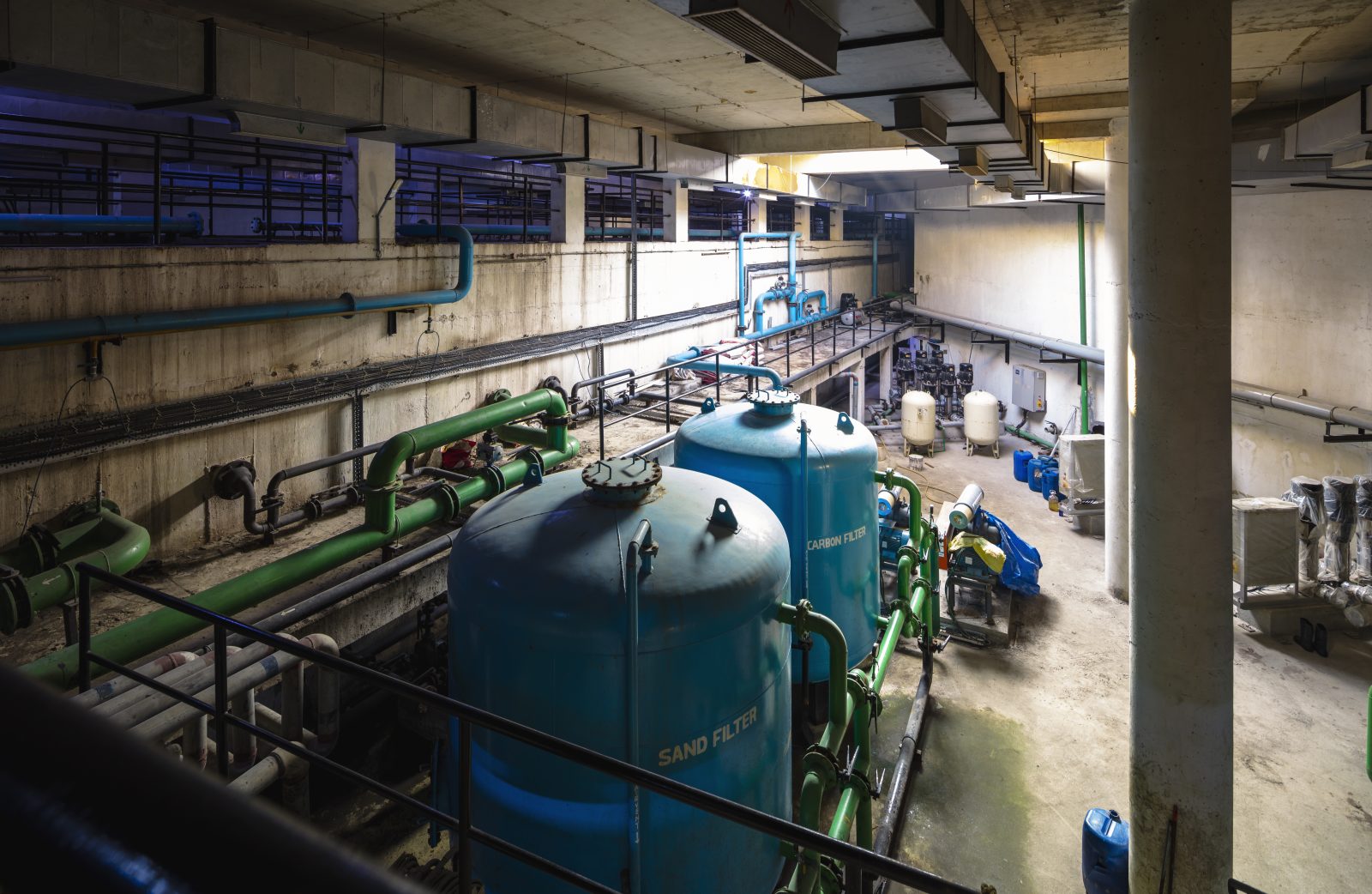Providing water to hundreds of households is not an easy task. The sheer quantum of water required on a daily basis is a formidable number. For example, at PBEL City, we require 22,00,000 liters of water per day.
To meet these demands water is sourced from multiple avenues. Municipal supplied water, Borewell water, water tankers, and recycled, STP water.

Every time you open your tap to wash your hands, you will be amazed by the complex network of pipes, devices and systems that are involved in the Water Management of our large scale residential projects.
To start off, its best to first understand how water is distributed across the homes.
Water Distribution
Basic Water Flow
The first three sources, municipal, bore-well, water tankers, are fed into the Fire Sump. The overflow from the Fire Sump fills the Domestic Sump. Water from the Domestic Sump is pumped to the overhead Fire Tank, which again overflows to the domestic tank. This ensures that the water required for Fire suppression is always available in this specially designed sump. Water from the overhead Domestic Tank feeds all water outlets in your apartment barring the flushes.

The used water from your shower, kitchen, toilets and bathroom sinks, is sent to the Sewage Treatment Plant. Once it is treated, this water is stored in a Treated Sewage Water sump at the STP. From here this water is further pumped to each tower’s own Over Head Flush Tank which feeds water to the flush tanks of all the toilets and is also used to irrigate the landscape.
Groundwater Recharging
Our projects are designed with storm water drains that collect water from across the project, including exposed rooftops and balconies. This water is routed to rain water recharge pits located across the project. This mechanism allows for groundwater to be replenished.
At some of our projects, such as One City, VB City and Viva City, we also have Rain water collection tanks that store harvested rainwater. This water is used for irrigation, flushing of toilets and can also be utilised during emergency situations, such as a fire.
Ancillary Benefits
The pipes used in our projects offer residents the benefit of lower noise levels.
We also extensively use low flow, water-efficient fixtures that are optimally designed to produce flow characteristics that imitate regular fixtures but are, in fact, using 30% less water than a regular fixture.
The brands that we use such as Grohe for CP fittings and American Standard for Sanitary fittings manufacture such low flow, water-efficient fixtures.
Sewage Treatment
Treatment and reuse of Sewage Water plays a significant role in dropping the overall quantity of water needed by a factor of 40.9%. For example, as mentioned earlier, PBEL City requires 22,00,000 liters of water a day for its 2807 families. Out of this 22 lakh liters, 13 lakh liters is required for Domestic purposes, 7 lakh liters for flushing and 2 lakh liters for irrigation. The STP takes care of both flushing and irrigation thereby reducing our daily requirement from 22 down to 13 lakh liters. Thereby reducing the need to procure 9 lakh liters of water.
Besides the upfront need to reduce the overall water requirement of the project. Water treatment plays a more holistic role in the grander scheme of things. Treating wastewater produces an effluent that will do as little harm as possible when discharged to the surrounding environment, thereby preventing pollution compared to releasing untreated wastewater into the environment.
Water Pressure Equalisation
For every 10 feet of vertical pipe, water pressure increases by a factor of approximately 4.3 to 4.4 psi. So the water pressure in the ground floor of a 20 storey structure would roughly be about 87 psi more than the topmost floor. That is a huge difference. To give you an equivalent, a diver 160 feet underwater would experience similar water pressure levels.

This extreme difference in water pressure can cause a lot of heartache in running an effective water distribution system within a residential building. Upper floors will suffer from very low water pressure levels, resulting in trickling water sources at all outlets. The lower floors will suffer from excess water pressure that leads to incessant damage to faucets, geysers, and pipes.
To mitigate this gravity-induced issue, we utilise a Dual Mechanism Water Equalization System that maintains a fixed water pressure across the entire building.
Pressure Reducing Valves – The First Mechanism
Like we said earlier, the lower floors suffer from extremely high water pressure levels. To mitigate this, we use a series of Pressure Reducing Valves placed at strategic intervals that are set at varied pressure settings.

These Pressure Reducing Valves are passive mechanisms, meaning they don’t require electricity or a motor to function. A spring-loaded diaphragm inside the valve opens and closes at the preset setting allowing water to pass through at the desired pressure.
This network of PRV’s effectively maintains a consistent water pressure in the range of 21 to 29 psi. The fixtures that we use are designed to effectively function between 7 to 58 psi. Operating within these ranges exponentially reduces the chances of fixtures getting damaged or gaskets bursting.
Pneumatic Booster Pumps – The Second Mechanism
The upper floors of a High Rise building inherently suffer from low water pressure due to the close proximity of the overhead tanks.

To solve this problem, we utilise, Pneumatic Booster Pumps. These pumps consist of two mechanisms, a motorised pump, and a pneumatically pressurised tank.
The tank contains a water bladder that fills up to a certain capacity. This bladder within the tank is pressurised by compressed air to a specific pressure that matches the desired water pressure. When someone opens a tap, water is fed into the pipelines at a high-pressure thanks to the pressurized tanks, when the water pressure in the tank starts to fall, the pumps switch on and refill water into the tank to maintain pressure.
The motors that power these pumps have a Variable Frequency Drive or VFD for short. A VFD allows motor-based systems to adjust the speed at which the motor runs. That speed is based on how much power the mechanical systems need to meet the demand of the building. The demand of the system is also referred to as the “load” of the system. By varying the speed the motor can meet the needs of the ‘load’ without using more energy than necessary. These VFD’s drop operating costs by a factor of 25-30%.
Pay per use
Unlike most apartment projects, each apartment’s Domestic water supply is metered individually. This gives residents the benefit of paying as per their usage. It also places the right metrics and measurements in place for people to be aware of their usage patterns and possibly encourage habits of frugality (refer to case study below) when it comes to water. The meters used on our Indis projects are compatible with our central Building Management System that keeps track of all utilities.
In fact, each apartment has an RDU (Remote Display Unit) that relays the reading of the meter to a display in each apartment. The RDU also relays DG usage and water usage to the residents flat.






